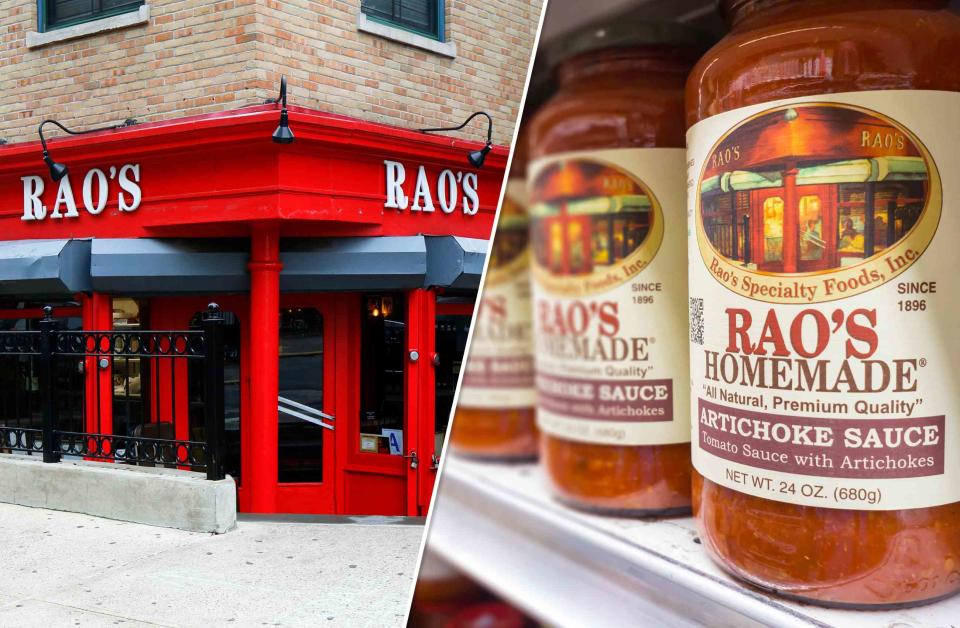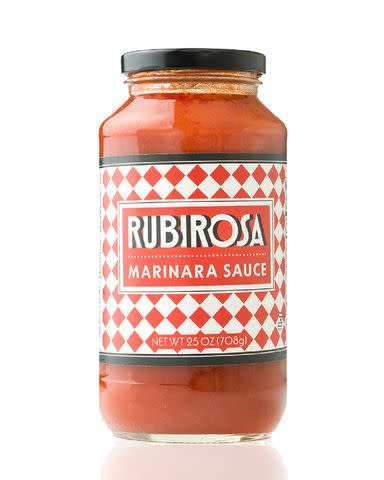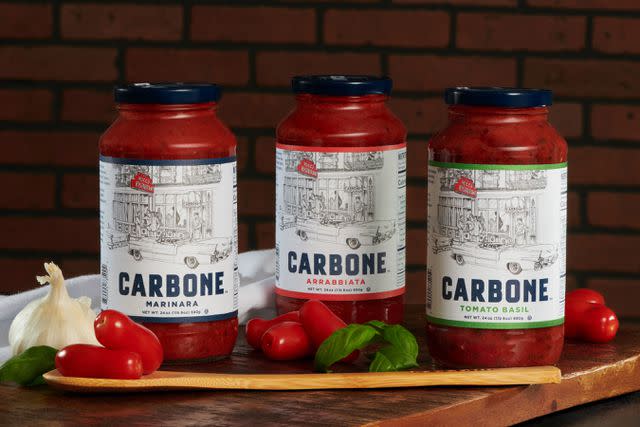What Happens When the Grocery Store Is the Buzziest Restaurant In Town?
Packaged sauces, oils, and salts are changing our relationships with restaurants for good.

Robert K. Chin - Storefronts / Alamy Stock Photo; Richard Levine / Alamy Stock Photo
On a recent Sunday, I decided to channel my ambient anxiety into organizing my pantry, a tiny corner of my humble kitchen that teeters freely between “pasta decanted into OXO pop-top jars” and “Ziploc baggies of spice blends labeled with smeared Sharpie marker.” Usually, I use this sort of activity to completely zone out, but this time, I found myself noticing how many restaurants were in my apartment: olive oil from Rubirosa, ramen noodle packets from Momofuku, and two beautiful bottles of Via Carota’s new pre-batched White Negroni.
If COVID-19 and the havoc it continues to wreak on the hospitality industry has taught restaurant operators anything, it’s that getting creative about revenue streams — from branded baseball hats to bottled cocktails — is worth the effort. But even decades prior to the pandemic, the grocery store aisle was a well-trodden path for several brick-and-mortar establishments. Rao’s –– the East Harlem restaurant where tables are famously reservable only by regulars –– started selling jarred red sauces in 1992; Ken’s Steakhouse, which first opened its doors in Framingham, Massachusetts back in 1941, launched Ken’s Foods to bottle its crowd-favorite house salad dressing in the ‘50s. “I think [Ken’s dressing] was always on shelves as a kid and my parents had heard that it was a very fancy steakhouse somewhere. But that was it,” says Brian Reinhart, dining critic at Dallas-based D Magazine. Likewise, a surprising number of people remain unaware of the connection between Rao’s sauces and their original location.
Both consumer brands are prime examples of packaged products that have, for all intents and purposes, eclipsed awareness of the restaurant from which they came. In 30 or 40 years, will people think of Carbone, which peddles five different red sauces across Whole Foods, Stop and Shop, and Amazon, primarily a packaged goods brand?
Setting aside my personal existential dread about whether I’ll have to someday tell my grandkids that Noodle Bar was where you went to soak up the happy hour drinks you ingested on St. Marks Place, there’s no denying the pleasantly equalizing effect of a buzzy restaurant like, say, Rubirosa shipping its marinara sauce across the country.
“[We] have one location in a historic building creating a “charming” footprint on Mulberry Street, but that also limits the amount of guests we can host per night,” says Bari Musacchio, one of the co-founders of Rubirosa at Home, which brings the iconic Soho Italian joint’s sauces, olive oil, and dried pastas to a nationwide audience. For Musacchio and her team, getting into the CPG (consumer packaged goods) game was about meeting “countless requests” for quarts of sauce, recipes, and pizza kits. But they’re also expanding their footprint without the baggage of opening additional spaces.

Courtesy of Rubirosa at Home
Similarly, in 2021, Major Food Group’s Carbone –– a favorite of celebrities like Beyoncé and the Kardashians –– extended its notoriously exclusive dining room with the launch of six red sauces. There are three U.S. Carbone locations across New York City, Dallas, Las Vegas, and Miami that can collectively seat roughly 500 guests; meanwhile, the company has sold more than 2 million jars of sauce across more than 10,000 stores nationwide, according to retailer data provider SPINS.
Meanwhile, for relatively prolific brands like Momofuku, which has fourteen restaurants across the United States, Australia, and Canada, or Tacombi, which boasts eleven locations in New York City alone, there’s an element of familiarity that makes entering the home pantry feel, well, comfortable. “When you look at the data, there’s a huge amount of Mexican food consumed in American homes,” says Tacombi founder Dario Wolos. Through Vista Hermosa, Wolos upholds the underlying mission of the restaurant –– “higher-quality Mexican foods” –– through packaged tortillas, chips, salsas, frozen burritos, and even canned beer, many of which are now available in some 2200 retailers nationwide. For Wolos, these goods are a way to plant the brand’s seed in states that don’t yet have a Tacombi, like Texas or Illinois, without committing to a costly brick and mortar build-out.
There are, of course, pitfalls in attempting to translate your entire operation’s soul into an eight-ounce jar. “It’s a totally different business model,” Musacchio explains. “We are constantly faced with challenges daily from packaging to logistics to selling products via different means. Luckily, the restaurant industry does prepare you for any challenge so this “grit” paired with our hospitality foundation has allowed us to apply this hospitality-style approach in our sales, marketing and customer service aspects.” While each proverbial restaurant-to-grocery-store sausage is made slightly differently, most operators point to a thorough research and development process, and in some cases –– like for Via Carota’s bottled cocktails –– build out their own distilleries and production facilities.

Courtesy of Carbone
Perhaps the most recent cautionary tale is Milk Bar, the whimsical bakery that, in 2008 took Manhattan by a storm of cereal-milk soft serve (and a since-rebranded butter pie). Milk Bar cookies hit Whole Foods, Target, and Amazon in spring of 2020, immediately triggering a wave of joy and, soon thereafter, vocal disappointment, specifically from customers who had hoped to replicate the experience of ordering at an actual Milk Bar. a chorus of disappointment.
“These are THE worst supermarket cookies I’ve ever had,” lamented one commenter on a related Reddit thread. “The few things I tried from the grocery store were extremely underwhelming and not a shadow of the real thing,” another said.
Multiple Amazon reviews for Milk Bar’s Confetti Cookies, one of the bakery’s most popular offerings, echoed the same sentiment. “I have been to the actual Milk Bar in NYC. I loved it there so much it is seriously like heaven to me…I purchased so many pre-packed cookies at the bakery to bring home to my mom in Jersey and she was also in love with the cookies. So naturally, I freaked out when I saw that my local Target in Portland Oregon now had them available to purchase… I was so sad to find that they were nothing at all like the cookies from Milk Bar.”
In the end, it’s worth questioning if it even really matters whether consumers are able to make the connection between a restaurant and its spin-off products. In some cases, the association might tarnish the parent brand’s reputation, preventing folks from wanting to visit or dine in; in others, the products might all but erase the parent restaurant from public consciousness. Either way –– i f you want to be properly represented in the shoppy shop, you've got to pick the best fighter.

